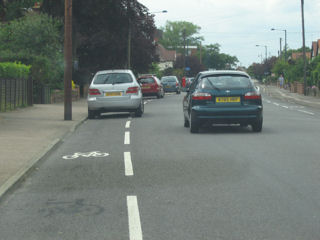

So what's wrong with cycle lanes? Don't they make journeys safer, more convenient and more pleasant for cyclists? In almost every case, the answer has to be a resounding 'no'. Cycle lanes offer no benefit to anyone, except (just possibly) the more aggressive motorist who wishes cyclists to be kept out of their way and off 'their' road, and (to a small degree) the suppliers of white paint. Cycle lanes are not facilities for cyclists, they are facilities whose sole function is to attempt to keep cyclists out of the way of other traffic.
When I say 'cycle lanes', I mean parts of the road itself, indicated by a solid or broken white line as intended for use by cyclists. I don't mean off-road cycle paths or cycle tracks, which sometimes offer some benefit, particularly where they provide a completely new route for cyclists in addition to the road network.
Cycle lanes on the road are amongst the most ill-considered cycle 'facilities' to exist, and in stark contrast to the intentions behind them, they tend to make cyclists' journeys more dangerous, less convenient and less pleasant.
To understand the problems with cycle lanes, it is firstly necessary to understand good road positioning for the cyclist. Unfortunately, too many motorists and cyclists think that good road positioning involves riding at a fixed distance from the kerb, and often very close to the kerb. Yet riding in the gutter exposes the cyclist to increased risk as they are less likely to be spotted by drivers, who are also less likely to give adequate distance when passing (a good rule of thumb is that drivers will, on average, give the cyclist as much space as the cyclist has given themselves from the kerb). Drivers are more likely to attempt to overtake gutter cyclists when it is unsafe to do so. The gutter is also often full of debris, as well as drain covers and lumpy paint such as yellow lines.
Undoubtedly the safest place for a cyclist to ride on the road is with the rest of the traffic. In light traffic or on wide roads, the cyclist is generally best to take the 'primary' position, i.e. the centre of the moving traffic lane (which may or may not coincide with the centre of the marked traffic lane). In heavier and faster traffic or on narrower roads where the cyclist's slow speed may inconvenience other road users, then a fair compromise is to adopt the 'secondary' position which is within the left half of the moving traffic lane -- but not in the gutter and still at a sensible distance from the kerb. If you're not convinced about this, I recommend that you read Cyclecraft (which is endorsed by the Department for Transport and which forms the basis for all good cycle training). See www.cyclecraft.co.uk.
Once the principles of good positioning are understood, then the deficiencies of cycle lanes become obvious.
But even faced with such deficiencies, one might say 'yes, but cycle lanes encourage people to take up cycling'. I doubt that this is true. The introduction of a cycle lane gives two very strong messages. The first message is that cycling is such a dangerous activity that it demands special 'facilities' on the road. (From this, it would also follow logically that ordinary roads are off-limits to cyclists and that the network of routes for cyclists is therefore much more limited than the network for motor vehicles.) The second message is that cyclists are second-class road users who should be marginalised. Not a great advert for cycling.
So can cycle lanes ever be good? In the light of the comments above, it may seem surprising -- but cycle lanes on the road can be a good thing in two very specific types of case. Firstly, cycle lanes can be useful in places where a particular exit at a junction is available to cyclists but not to motorists. Examples would be 'cycle gates' which enable a cyclist to turn at a junction where the same turn is prohibited for motor vehicles, or filter lanes for cyclists to turn into a road or cycle path where motorists cannot enter. Secondly, contraflow cycle lanes on road which are otherwise for one-way traffic can provide a convenient additional route to ride along. In both cases, cycle lanes are of limited benefit unless they are constructed to excellent design standards, including in particular an adequate width.
So how should we deal with cycle lanes? If on-road cycle lanes are proposed, then motorists, cyclists and pedestrians alike should campaign vigorously against them. If they already exist then we should seek their removal. But we also need to know how to ride/drive where there is a cycle lane.
For motorists, remember that the cyclist is perfectly entitled to use either the cycle lane or the 'all-traffic' lane. The Highway Code suggest using cycle lanes where it is safe to do so -- which is rare, so don't be surprised to see cyclists using the main traffic lane. Wherever the cyclist is riding, be patient and always leave a good passing distance -- at least as much as you would leave if you were overtaking a moving car. Remember that, even if it seems like the cyclist is holding you up, the effect on your journey of being patient will normally be minimal or zero. If the cyclist catches you up at the next junction, then the overtaking manoeuvre was pointless!
For cyclists, also remember that you should cycle wherever is safest, and try to adopt the primary/secondary position by reference to the moving traffic lane. Don't let the road markings mislead you about where to ride. Never ride in the gutter, and always make sure that there is enough space between you and the kerb to provide a margin for error (yours or the motorist's). Be aware that you're slower than the motorist so, whether you're in the cycle lane or the main traffic lane, look for opportunities to let motorists overtake in heavy traffic when it's safe, but assert your road space and dissuade overtaking when there's not enough space. Unfortunately, you may find that in some areas the level of abuse and aggression you suffer from motorists when you ride in the main traffic lane forces you reluctantly to seek refuge in the cyclists' ghetto -- the cycle lane.
The photos give some examples of bad practice from High Road East, Felixstowe, not King's Lynn, but they serve as good examples
004: After passing the parked car, the cycle lane invites the rider to swerve sharply in towards the mouth of the junction.

006: Where there is a centre island, cars are unlikely to leave enough room. These cycle lanes are around 1.5m wide, considerably narrower than the recommended minimum standard of 2m.

010: Parked cars make a nonsense of the cycle lane.
